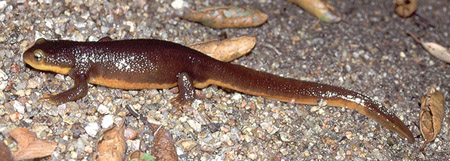- Taricha
Taxobox
name = Western Newts

image_width = 240px
image_caption = "Taricha torosa "
regnum =Animal ia
phylum = Chordata
classis =Amphibia
ordo =Caudata
familia =Salamandridae
genus = "Taricha"
subdivision_ranks = Species
subdivision = "Taricha granulosa "
"Taricha rivularis "
"Taricha torosa "The genus "Taricha" consists of three species and four subspecies of Western
Newts (sometimes referred to as Pacific Newts). All newts are part of the familySalamandridae . The three species within this genus are theCalifornia Newt , theRough-Skinned Newt , and theRed Bellied Newt , all of which are found on the west coast of theUSA .Species
Genus "Taricha" (Western Newts / Pacific Newts) - 3 species
*Rough-skinned Newt ("Taricha granulosa")
*Red-bellied Newt ("Taricha rivularis")
*California Newt ("Taricha torosa")Differentiating between species
The
Rough-skinned Newt ("T. granulosa") and theCalifornia Newt ("T. torosa") share several characteristics. Both are light brown to black on the upper body and orange to yellow on the underbelly. They have "pebbly" skin that is not slimy and they may grow to a length of 8 inches, which is large for asalamander . However, there are a few characteristics to tell them apart. Rough-skinned Newts have small eyes with dark lower eyelids, while California Newts have large eyes and light lower eyelids. Also, rough-skinned newts' upper teeth form a V shape, while those of the California newt form a Y shape. However, this is difficult to ascertain on a living specimen.The
Red-bellied Newt ("T. rivularis") is brown on the upper body with a red underbelly, has grainy skin, and grows to between 5.5 and 7.5 inches. It can be distinguished from other coastal newts, not only by its red belly, but also by the lack of yellow in its eyes. Breeding males develop smooth skin and a flattened tail.Behavior
"Taricha" spp. eat a diet largely consisting of
invertebrates such as Blood worms and mosquito larvae. Most predators associate bright colors with poison (calledaposematism ) and therefore, if attacked, the newt will take up a defensive position, showing off the bright underbelly. If the predator is not deterred by this display the newt will probably be its last meal. Newts of this genus are primarilynocturnal and may be either fully aquatic or semi-aquatic. None are fully terrestrial as they must enter the water to breed. Juvenile newts, which are known as "eft s", are primarily terrestrial until they reachsexual maturity .Toxicity
All species within the genus "Taricha" possess the biotoxin
tetrodotoxin (TTX), one of the most potent toxins known to science. However, the degree of toxicity varies between species and between populations within a species. In general, theRough-skinned Newt (T. granulosa) is the most toxic species. Rough-Skinned newts from populations inNorthern Oregon are more toxic than those fromCalifornia andWashington . Those onVancouver Island , inBritish Columbia , possess little or no TTX. "Taricha" can be lethal to humans if ingested and at least one human fatality occurred in Oregon from eating a Rough-skinned Newt.Eastern newt s of the genus "Notophthalmus" (="Diemictylus" of earlier authors) also secrete TTX, but in lesser amounts. When handling "Taricha" the toxins should not be allowed to come in contact with unbroken skin ormucous membrane s. Proper hand washing after handling should prevent any problems with infection fromSalmonella (which newts are known to carry) or ingestion of TTX, however, some individuals are known to be allergic to skin contact with the toxin. Also, as amphibians' skin is very permeable, hand washing before handling will reduce the possibility of the newt absorbing bacteria or other contaminants from the handler.. see [http://www.caudata.org/cc/articles/toxin2.shtml www.caudata.org; Newt Toxins] Accessed2007-12-01 ]These newts are, however, often kept as pets and with proper lighting, feeding and hygiene they will readily adapt to aquarium life.
References
Wikimedia Foundation. 2010.
